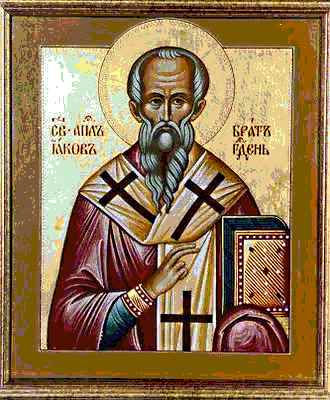
The Nazarenes
After Jesus ascended to heaven, many of his followers stayed in Jerusalem and gathered into a closely-knit group that became known as the Nazarenes. According to Acts 1:13-16, the group initially had about 120 members, including Jesus' mother Mary and all of his brothers. The two main leaders were Simon Peter and the oldest brother of Jesus, who was called James the Just. During an early meeting a man named Matthias was chosen to replace the traitor Judas Iscariot in the inner circle of the twelve primary disciples.
The Nazarenes were the original core group from which Christianity grew and spread. But initially they still considered themselves to be Jews. They prayed in the temple at Jerusalem, and they followed most of the traditional Jewish religious practices. Other people in the city regarded them as a new Jewish sect.
But the Nazarenes differed from other Jewish sects in a fundamental way, for they believed that Jesus was the Messiah. They boldly took this message into the streets of Jerusalem and soon began to attract many new converts. They also spread the message to friends and relatives who lived in other places, and within a few years small groups of believers were established in several other cities.

An unknown artist painted this representation of the Nazarene leader James the Just, who was the oldest brother of Jesus.
At first most of the new converts were other Jews, many of whom were already interested in the prophesies about the Messiah. But then the apostle Paul began to convert many non-Jews (Gentiles). This led to a controversy when some Nazarenes from Jerusalem visited a community of new believers in Antioch and told some Gentile converts there that they would have to be circumcised in order to be saved. Paul strongly disagreed with this, and he made a special trip to Jerusalem to try to resolve the issue.
When he reached Jerusalem, a meeting was held to discuss the matter. Although some of the Nazarenes argued against Paul, Peter apparently took his side. After a lengthy debate, the final decision was that Gentile converts didn't have to be circumcised, but would still have to obey the Jewish laws relating to idolatry, sexual morality, and diet. This important meeting, sometimes called the Council of Jerusalem, is described in Acts 15:1-29.
During these early years the converts in other cities regarded the Nazarenes in Jerusalem as the final authority for deciding important issues. This was mainly due to the presence of Peter, James the Just, and other original believers. They were granted a special status because they had known Jesus personally.
But Peter eventually left Jerusalem. And mostly because of Paul's activities, the number of converts in other cities grew rapidly. For these reasons, the Nazarenes began to lose their influence. As the years passed, their continued adherence to the old Jewish religious practices left them increasingly out of touch with newer believers, many of whom came from outside Judaism.
In 66 AD a fierce war broke out in Palestine between the Roman army and a group of Jewish rebels. The casualties were enormous, especially among civilians, but most of the Nazarenes were able to save themselves by abandoning their homes and fleeing from Jerusalem. According to the church historian Eusebius, many of them fled to a place called Pella east of the Jordan River. But although most of them escaped, they had suffered a terrible blow.
By then Christianity had begun to separate from Judaism, and the Nazarenes quickly lost any remaining influence they might have had. There is evidence that many of them never accepted Paul as a true apostle and didn't approve of some of the practices in the churches he established. Perhaps partly for this reason, they gradually became isolated from the main Christian movement, and had little effect on the subsequent history of the church.
The Nazarene Way of Life
During their years in Jerusalem, the Nazarenes sometimes called themselves followers of "The Way". By this, they apparently meant their way of life. According to Acts 4:32-33:
All the believers were one in heart and mind. No one claimed that any of his possessions was his own, but they shared everything that they had.
In addition to their insistence on sharing, the Nazarenes put a high value on devoutness, non-violence, and a very simple lifestyle. All of these ideas could have come directly from the teachings of Jesus. Many scholars have pointed out that the Nazarenes' lifestyle was similar to that of the Essenes. But theories about possible connections between the two groups are difficult to prove.
The origin of the name "Nazarenes" is uncertain. Because Jesus himself was sometimes called "the Nazarene", one frequent suggestion is that the name was derived from "Nazareth". But this can't be proven, and there are reasons to doubt it. Some of the uncertainty stems from the fact that ancient writers spelled the name in several different ways, including "Nazirenes", "Nazaraeans", and "Nazoreans".
Persecution of the Nazarenes
Even in the early days, when the Nazarenes were still a small group, they were already being persecuted by the local Jerusalem authorities. The stoning of Stephen, the first Christian martyr, is starkly described in Acts 7:54-60. The threat of further executions caused others in the group to temporarily go into hiding. It was during this period that Paul (then known as Saul) got involved in the persecutions, although it isn't clear how big a role he played.
Later, during another flareup of persecution, James the son of Zebedee was put to death with a sword. Peter would have probably also been executed, but an angel came during the night and helped him escape from jail. Apparently he avoided further trouble until his later years, but finally, according to church tradition, was killed in Rome. James the Just also managed to survive the early persecutions, but was eventually killed in 62 AD.

This painting by French artist Jacques Stella depicts the stoning of Stephen.
The Fate of the Nazarenes
After they fled from Jerusalem, the Nazarenes gradually became isolated from the main Christian movement. Despite this isolation, they still managed to survive for several centuries as an independent sect. Their survival was mentioned by several later writers, including Saint Jerome, who reported that he visited a community of them in the Syrian desert in about 380 AD.
Many scholars think that another group of them survived under the name Ebionites. These Ebionites recognized Jesus as the Messiah but considered him to be of normal human parentage. They adhered to the old Jewish laws, had their own gospel, and disapproved of the teachings of Paul. For these reasons, the fourth-century Bishop Epiphanius declared them to be heretics.
There aren't any reliable reports of what finally happened to either the Nazarenes or the Ebionites. Quite possibly both groups completely died out soon after the fourth century. However, a few scholars think that small communities may have survived for a longer period in remote areas. There has also been speculation that some late survivors were progenitors of medieval heretical groups such as the Cathars. But unless new information is uncovered, the final fate of the Nazarenes will remain a mystery.
Note: According to legend, a modern group of Christians known as the Nazarenes of Malabar (India) was founded by the disciple Thomas in 52 AD, and thus could be an offshoot of the original Nazarenes of Jerusalem. Another modern group, the Nazarenes of Mount Carmel, claims to be a "modern resurrection" of the original Nazarenes of Jerusalem. Yet another modern denomination, The Church of the Nazarene, apparently has no direct connection to the ancient sect.
More Mysteries
- Demonic Possession
Can people be possessed by demons? - Golgotha
The crucifixion of Jesus took place at a site near Jerusalem called Golgotha. But exactly where was it located? - The Resurrection of the Dead Saints
How can we explain this mysterious passage in the Gospel of Matthew? - Family of Jesus
Did other members of his family initially disapprove of his activities? - Stigmata
What causes these mysterious wounds? - The Virgin Birth
Is there a natural explanation? - Judas Iscariot
Why did he betray Jesus? - First Witness to the Resurrection
Who was the first person to see Jesus after he left the tomb? - Barabbas
Why was he released instead of Jesus? - The Devil
Does he really exist? - Who Was at the Cross?
Which of his followers saw him die? - Mary Magdalene
Did she have a special relationship with Jesus? - James the Just
Why do the gospels say so little about this very important early church leader? - Speaking in Tongues
Can some people speak in a divine language? - Jesus Teachings
Why do some of his teachings seem so radical? - Additional Mysteries
The Antichrist .... The Harrowing of Hell .... Incorruptible Bodies .... The Wandering Jew - Free Gospel Mysteries eBook
- Gospel Mysteries
Contact Email
